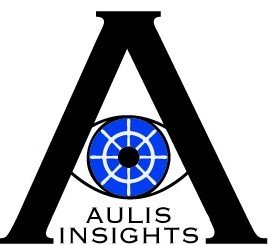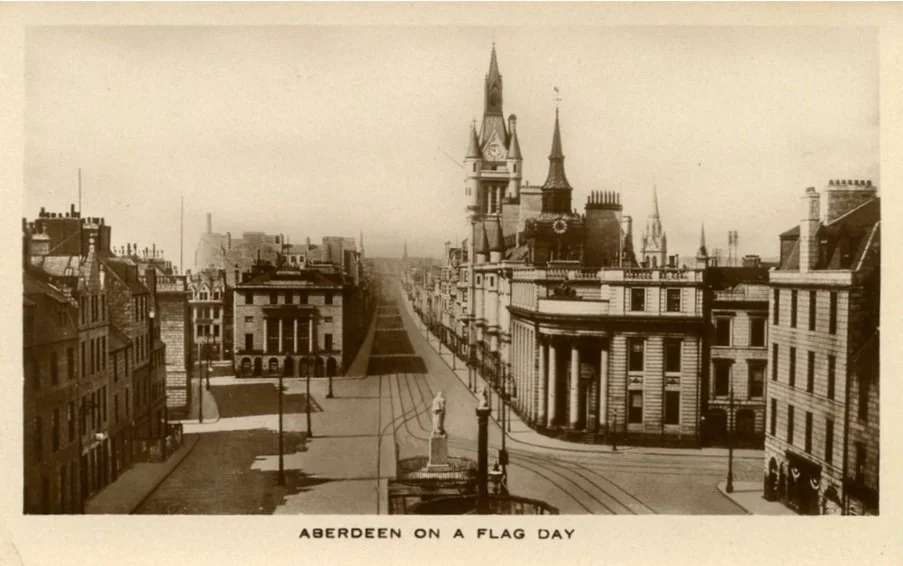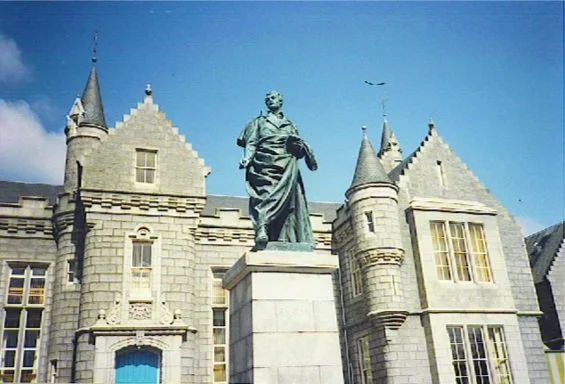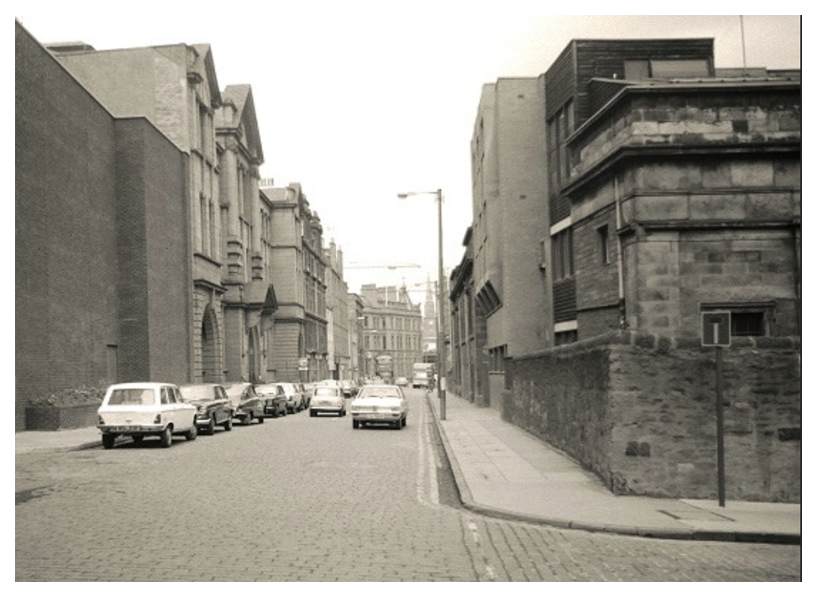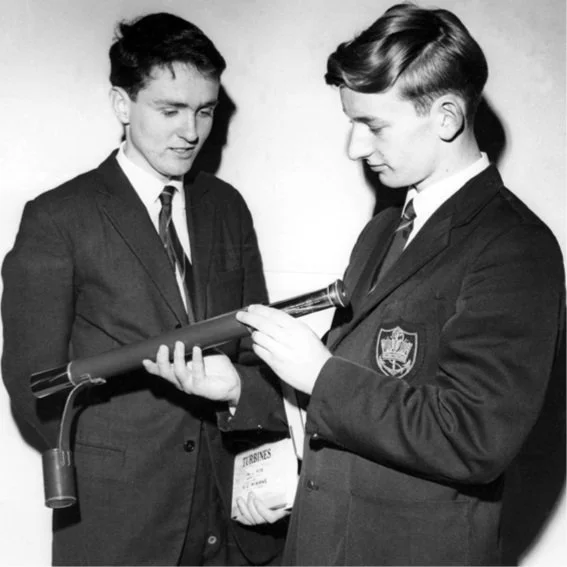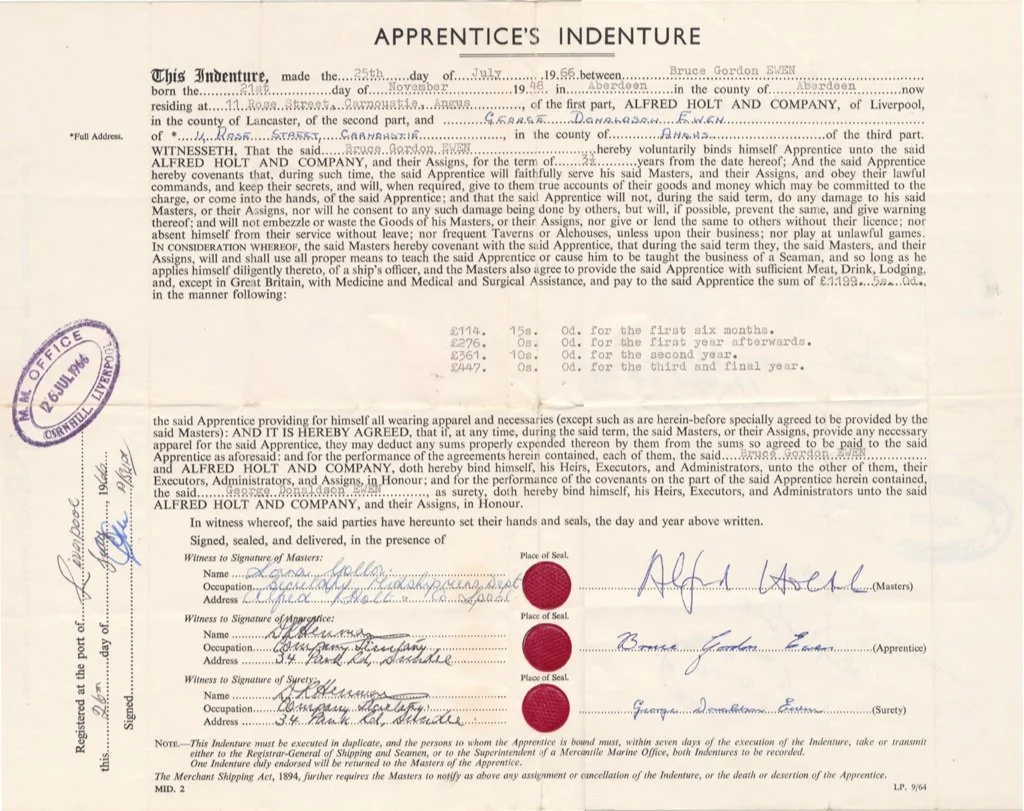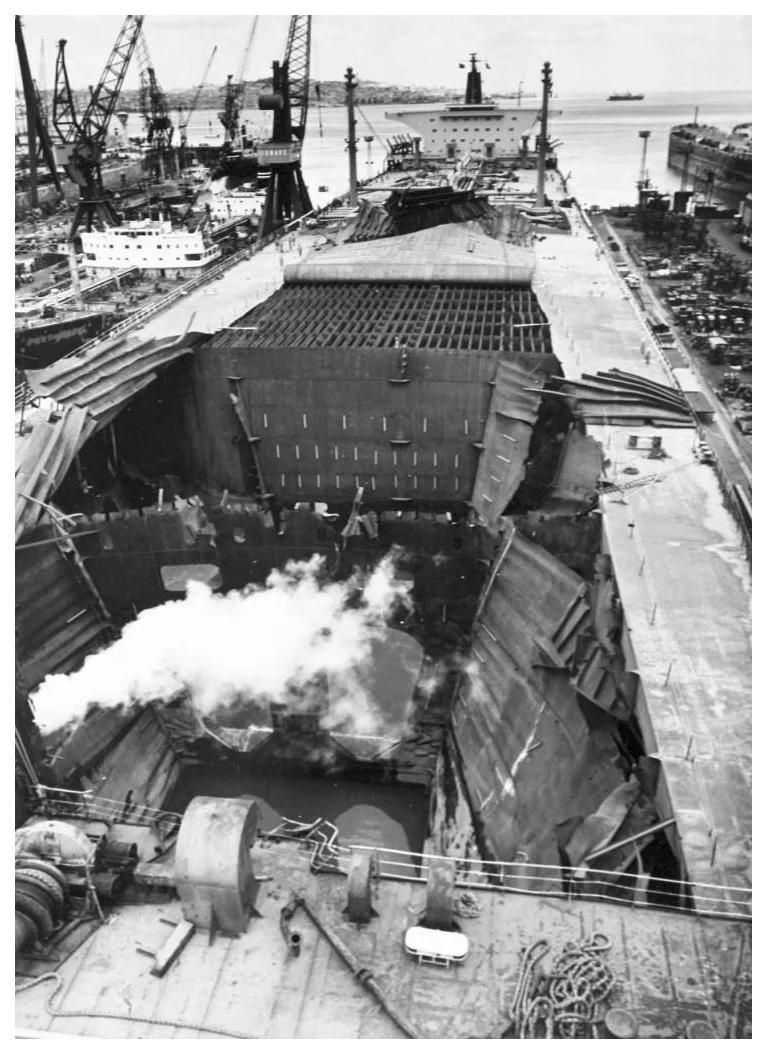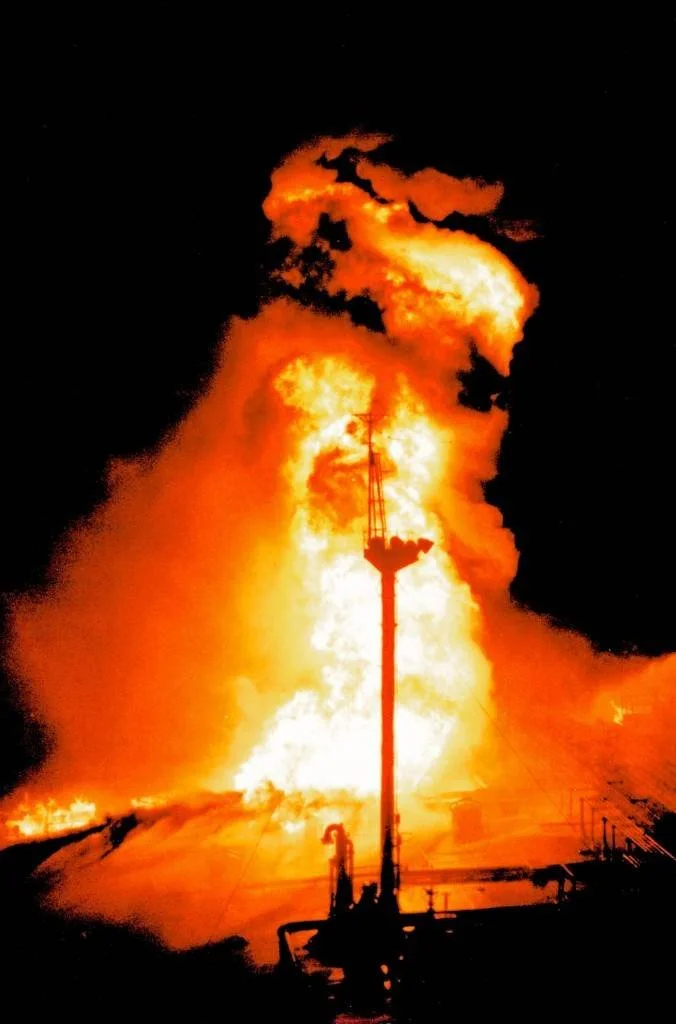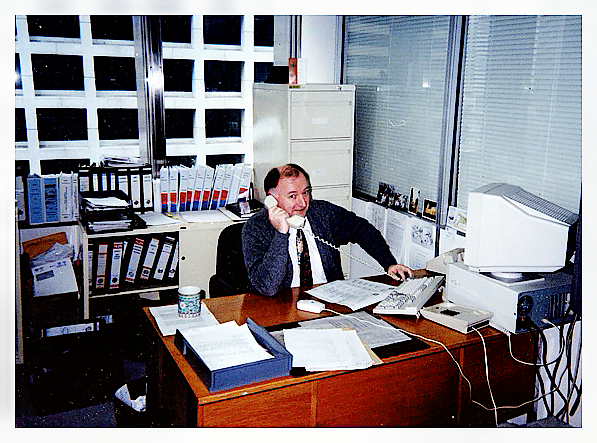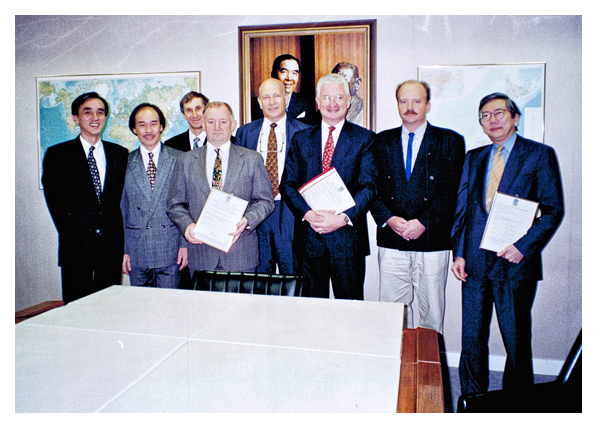Life and Times
I was born on 21st November, 1948 in Aberdeen, Scotland, the son of a journeyman electrician and a housewife (i.e. a mother who stayed at home to look after the children). I had one uncle who had been an engineer with Clan Line but otherwise, all near and distant relatives were established landlubbers.
In those days, Aberdeen was the biggest fishing port on the northeast coast and that, together with agriculture, was the main source of the city’s prosperity. I spent many happy hours wandering around Aberdeen harbour in general and the fish market in particular. Today, the fishing has more or less gone but the oil services industry is thriving.
Aberdeen on a Flag Day – A Famous Postcard Photo
My formal education started at Aberdeen Grammar School and continued there until I was eleven when, after passing the dreaded “11-plus” exam, I relocated to Carnoustie since my father had taken employment in nearby Dundee.
Aberdeen Grammar is better remembered for having had Lord Byron as a pupil from 1794 to 1798 and they even erected a statue of him despite his short attendance period.
Byron’s statue on the school grounds
Living in Carnoustie, my father had the option of sending me to school in Dundee, where he worked, or Arbroath, which was 10 miles in the opposite direction. He chose Arbroath.
I attended Arbroath High School until 1965 and will not be added to its very short list of notable students, amongst whom is Andy Stewart, writer and singer of “Donald Where’s Your Troosers” and other amusing ditties.
I did, however, learn to play golf on the many courses in and around Carnoustie so my time there was not completely wasted and that experience culminated in my hole-in-one at the 9th hole, Marina Bay Golf Course, Singapore, on 14th May, 2010, but I digress.
Arbroath High School
With nothing better in mind, I decided that a career at sea might be an idea. I was accepted into Dundee Pre-sea School, housed at Bell Street Technical College, and in the autumn of 1965, started learning something completely different. Fortunately, I enjoyed it.
Bell Street Technical College. Dundee
Dundee, in those days, was the heart of the jute industry in the U.K. and much of the technological developments for that industry came from Bell Street Tech as it was known. Ships carrying jute arrived from Pakistan every other day and, together with a colleague, I would visit the ships to chat to the officers, get shown around and have an invariably excellent curry. Those were the days before ISPS of course, so ship-visiting was perfectly commonplace and indeed, encouraged.
The Odyssey Prize
In June 1966, I completed the course by becoming the top navigation cadet and the top cadet overall, for which I was awarded the Odyssey Prize: a telescope presented by Alfred Holt & Co. Ltd. The fact that I had just agreed to become an indentured apprentice with them had nothing to do with it.
Yes! £114 15s for the first six months, or £19 12p a month. I was on my way!
I arrived in Liverpool at the end of July 1966 and stayed at Aulis (see the ‘Aulis‘ page). After attending the Odyssey Works in Birkenhead to be taught some rudimentary seamanship and derrick work by a gnarled old Bosun, I joined my first ship as midshipman (or ‘middy’), m.v. “Automedon”, at Vittoria Docks, Birkenhead, on 16th August 1966.
“Automedon” was a general cargo ship of 9,320 tons summer deadweight, launched at Vickers-Armstrong yard at Newcastle-upon-Tyne in 1948 and delivered in August 1949 as part of the continuing fleet renewal programme after the loss of 41 Blue Funnel ships (and 3 from Glen Line) during the Second World War. Sadly, after a collision with m.v. “San George” on the river Schelte on 17th December 1972, she was declared a constructive total loss and was scrapped in Kaohsiung in March 1973.
m.v. Automedon, Vittoria Docks, 16th August 1966
Shimizu. The clean ‘middy’.
We sailed to the Far East via the Suez Canal, stopping at Aden (then under British control) for bunkers and visiting (if I remember correctly) Penang, Swettenham (now Port Klang), Singapore, Hong Kong, Nagoya, Shimizu, Kobe, Yokohama and Pusan, before revisiting some of the ports on the homeward leg.
Life as a midshipman mainly involved working under the Bosun as an extra crew member. It was usually hot, always dirty and a lot of fun. When we did hit port, where we stayed for several days at a time, unlike today, we were allowed ample time ashore to let off steam and our slim finances were often supplemented by the Chief Officer releasing a little of his ‘cumshaw’. The padres from the Missions to Seamen were always excellent at arranging interesting (and cheap) entertainment.
I was enrolled on the 5th Ordinary National Diploma in Nautical Science course at Riversdale Technical College in Liverpool so after completing three voyages (all my ships are shown in the “Nostalgia” page), I spent 6 months ashore completing Phase 1 of the course. After that, I returned to sea as a Cadet Officer, which meant working with the Deck Officers learning bridge and cargo work. Unfortunately, I have no photographs from that period.
In January 1969, I returned to Liverpool to complete Phase 3 of the OND course and after a few days at sea to complete the required sea-time, I studied for and obtained my Second Mate’s Certificate.
I had achieved a good pass at OND and was invited to enrol on a BSc course but at that time, I had had enough of classroom activities so decided to try something different. Blue Funnel by that time had morphed into Ocean Fleets and we had been advised that the days of general cargo ships were numbered. We were invited to apply for a position on the first generation of container ships (‘box boats’) but they did not appeal to me.
I joined another Liverpool company called Moss Hutcheson Line – a small cog in the large P&O machine – as Third Mate and sailed on short voyages to Mediterranean ports on general cargo ships. The run was excellent, but I did not take well to the very short voyages (6 weeks or less) so decided to try my hand at tankers.
By that time, I was married, and Mobil Shipping Company of London was advertising “A Wife on the Ocean Waves”. In other words, any officer could take his wife to sea without first serving a probationary period. On 27th September 1970, my wife and I joined my first tanker, “Mobil Transporter”, off Dubai. For the next 4 or 5 days, we were both laid up with dysentery contracted while staying in a Dubai hotel. Dubai in 1970 was not the gleaming, cosmopolitan city we see today and most of the international travellers were either aircrew or seafarers. The aircrew stayed in the hotel without dysentery.
“Mobil Transporter” wasn’t really a tanker. She was a jumboised OBO. Part of her had been the midship’s accommodation “Mobil Mariner”, built 1954, and after placing the midship’s accommodation on top of the aft engine room, they cropped the tanker bit off and stuck a new OBO bit on. This was done in 1969. The forward section with the cargo holds/tanks was wider than the original after section so she looked quite odd. The voyages were continuously westbound, loading oil in the Arabian Gulf (as we then called it), discharging in Paulsboro, New Jersey, cleaning for coal, loading fine coal in the Chesapeake Bay area, transiting the Panama Canal, discharging coal in Japan (usually Fukuyama) then changing over to oil and repeating the voyage. The run was good, the ship was technically ‘interesting’ and life on board was always fun.
At sea. The dirty “middy”
I was fortunate to be in Mobil at that time. In common with Blue Funnel, the personnel management was excellent and the training afloat and ashore was of the highest order. It was also a good time to be going through the ranks since there was a shortage of officers and promotion was rapid. On obtaining my Chief Mate’s certificate in late 1971, I was immediately promoted to Second Mate and joined my first VLCC, t.t. “Mobil Pegasus”. She was one of a series of double-bottom VLCCs that Mobil owned and operated. In those days, these ships did not have inert gas and although the VLCCs “Mactra”, “Marpessa” and “Kong Haakon VII” had all exploded while tank cleaning in December 1969, no conclusion as to the cause and remedy had yet been reached. New VLCCs were still being delivered with fixed tank-cleaning systems, but no inert gas. The Mobil VLCCs did not have fixed tank cleaning systems. On 21st June 1973, “Mobil Pegasus” suffered a massive explosion in No. 1 Centre Tank while ballasting after tank-cleaning and shortly after that, Mobil began an inert gas and fixed cleaning system retro-fitting exercise on all vessels.
The first vessel I joined with an already-installed inert gas system was “Mobil Petroleum” in August 1974 although I was on the “Mobil Energy” when her system was being installed and commissioned in May of that year. Inert gas had, of course, been in use before, by Socal (now Chevron) as far back as the 1920’s and more recently by BP, but the focus was on corrosion reduction rather than safety during tank-cleaning. At least, that is my understanding.
In early 1973 I was Second Mate on “Mobil Astral”, when the fates put me in the right place at the right time and I was promoted on board to Chief Mate on 26th March 1973 at the tender age of 24 years and 4 months. Funnily enough, “Mobil Astral”, 100,000 tons deadweight conventional tanker, was built with a Peabody inert gas system installed, but when I joined her, it had already fallen into disrepair and was never used. By the time I had sufficient sea-time to sit for Masters, I had already been Chief Mate on seven tankers, with the last one being the tank-cleaning of “Mobil Magnolia” for her guarantee dry-docking in Sasebo. When I joined her in Singapore, she had just blown a hose off the manifold while discharging so the entire ship from midships to aft was covered in crude oil (not to mention a large part of Singapore’s western roads). The first part of the tank-cleaning was external!
“Mobil Pegasus” at Setnave after the explosion © Malcom Foster
I studied for my Master’s certificate in Hull and while I walked through the written exams, the examiner did not like my orals presentation. Mobil asked me to go back to sea as a favour so I completed a voyage on “Mobil Eagle” then successfully re-sat my orals in Liverpool. By that time, I was getting itchy feet again and although agreeing to complete a contract on “Mobil Condor”, I told Mobil that I would be leaving on completion. I’m glad I did because the “Condor” was an absolute cow of a ship which required an enormous amount of effort to keep it in running order so at least I left of my own free will and not because of the “Condor”. Coincidentally, “Mobil Condor” was the ex “Titan” which was Blue Funnel’s first tanker or at least, first VLCC. One of the sister ships was “Halcyon The Great” which fled Come-by-Chance in Canada in the dead of night and without tugs to avoid being impounded after the collapse of the owners, Court Line. The Master then joined World-Wide – my next company.
While I was sailing with Mobil, the ships were mostly ‘foreign flag’ i.e. Liberian, and the cargoes were Mobil-owned cargoes. I decided I wanted to sail for an established foreign flag company with ships under time and voyage charters. I shopped around but eventually decided to accept an offer from World-Wide Shipping. At that time, their main office was in Hong Kong but they had a subsidiary office in London. I was taken on as Chief Mate and offered the “World Knight” or “World Princess”. Since I knew “World Princess” was also a sister ship of “Mobil Condor”, I elected for “World Knight” which, by yet another coincidence, “Mobil Magnolia” had been berthed alongside in Sasebo and whose naming ceremony I had attended.
I found that sailing on time-chartered voyages was fascinating. We had to be aware of every aspect of the charter party in order to protect owner’s interests and the efficiency of the ship became paramount. World-Wide at that time were masters of the art of charter parties.
In early 1979, I was promoted to Master. My first command was “World Prestige” which was a VLCC previously bareboat-chartered to Japan Line and had been renamed from “Sanko Lake” some years before. To the horror of most of the deck officers, she was not fitted with inert gas, but being very familiar with the tank-cleaning methods to be employed in such circumstances, I was not too concerned. Anyway, she did not blow up.
I undertook numerous other voyages as depicted in the “Nostalgia” page, with the only one of note being in command of the 412,000 tonnes deadweight ULCC “World Petrobras” when she was a mother vessel off Larak Island on charter to the Iranian National Oil Company. This was in late 1987 at the peak of the Iran-Iraq war. Shuttle tanker VLCCs used to load at Kharg Island in the northern gulf and pump the cargo into the ULCC motherships off Larak. We in turn pumped it into export tankers. Many of the shuttle tankers arrived in the morning gloom streaming oil behind them having been struck by an Exocet missile in the forward section. Others were not so lucky when the missile struck the engine room, as happened to my first ship in World-Wide, “World Knight” when tragically, 10 people were killed as a result of a missile strike in the northern Gulf.
“World Petrobras” on fire as seen from the bridge.
Every day, or every other day, we were given a “103” signal over the VHF, which meant “Incoming aircraft – safety helmets on” or something. In the early afternoon of 22nd December, we did not hear a “103” but the aircraft came anyway. At the time, we had the shuttle tanker “Free Enterprise” on our starboard side and the export tanker “British Respect” on our port side. “World Petrobras” was completely full at the time so the shuttle tanker was simply pumping directly through our lines to the export tanker. We did, however, have our inert gas running. At 13:32, a Mirage F1 aircraft flew down our centre line and dropped two 500 lb bombs which struck the centre of the manifold area and No. 5 port wing tank. Shrapnel went everywhere and a large fire erupted, but thankfully, due to a crew and provision boat having just arrived at the stern, nobody was standing near the points of impact and nobody on board was hurt. The fire burned until about 21:00 when finally, the attentions of 11 fire-fighting tugs managed to quell it. The fire erupted again at about 01:00, but it was just a local fire in the central store room and was easily extinguished. The story is briefly recounted in the book, “A Century of Tankers” by John Newton, © Intertanko, ISBN-10: 8299659604 pp. 116-118, and referred to in “The Tankship Tromedy” by Jack Devanney, ISBN: 0-9776479-0-0, pp. 32-33.
First day as Port Captain
I arrived in Singapore on 17th June 1995 and have stayed there ever since. World-Wide had had an office in Singapore since the late fifties, but now the entire fleet of about 36 vessels was going to be managed out of there. The office was being run out of Park Mall across from Dhoby Ghaut MRT station at the time of our arrival, but after about a year, we moved to a new office in Suntec City, Tower Two. At that time, there were only 2 towers, but the others were soon built and the area became a bustling office, shopping and dining complex. We set about getting the entire fleet through ISM again, since at that time, the Singapore fleet had not been certified and the ex-Hong Kong fleet had to be re-certified. For this part of the operation, Denis Keith continued to assist and we were reinforced by Geoff Arnold and rotating secondments from the fleet. Once that had been done, I was moved to Operations (post-fixture support) and eventually became Senior Vice-President (Operations). After a while, I felt a change was necessary. I had spent 22 years with World-Wide in various capacities but my feet were itching again, so I moved into surveying and consultancy with Maritime Claims & Services (MCS).
MCS was owned and run by Capt. Richard Howe, who remains the only person to have sailed a solo circumnavigation of the globe from Singapore to Singapore. (We had many interesting conversations about keeping a good lookout when sailing solo). I learned a lot from Richard. MCS was correspondent for the West of England P&I Club and also Michael Else & Co. amongst others, so we had both the mutual and fixed premium perspective. Although I had started off on general cargo ships, my recent experience of many years was on tankers, so I rapidly became familiar with various types of dry cargo vessels again. Added to that, some major changes were coming through in the form of VDR and AIS requirements amongst others and we became involved at an early stage with Rightship vetting inspections. I vetted close to 30 vessels for Rightship and also audited several shipping offices in Singapore, Malaysia, Hong Kong, China, Taiwan and Greece. Over the next few years I began to specialise in casualty investigation supported by both 2D and 3D computer reconstruction of events.
In late 2007 I was invited to join Clyde & Co, Singapore, as their Senior Master Mariner. I was actually their only Master Mariner in Singapore, but every company has titles they like to confer. After some consideration I decided that the move was right for me at that time so joined them in February 2008. During the next six years, I was involved with several serious casualties including the collision between “Yao Hai” and “Neftegaz 67” in Hong Kong and the foundering of the jack-up rig “Perro Negro 6” off Angola. I took part in Clyde’s maritime conferences and gave occasional talks on maritime matters.
In early 2014, I decided that I would prefer to work for myself rather than commit to full-time daily work in an office, so Clyde & Co and myself parted company by mutual and very friendly agreement. I have great respect for Clyde & Co and had the pleasure of working with some wonderful colleagues during my time there. I set up Aulis Insights Pte Ltd and have since done some diverse work such as collision reconstruction, collision investigation, bunker quality disputes, oil cargo losses, submarine cable damage etc. These include the preparation of expert witness reports.
My CV can be had on request and some examples of my work are on the Activities page.
I continued at sea in the position of Master until late 1993. At that time, I was in command of the first generation double-hull VLCC, “Soro”. I was invited to come ashore to the main Hong Kong office as Port Captain. Since I had recently bought a house in Florida and my plan was to vacation there every leave period, I was in two minds, but my second wife is from Hong Kong, so some domestic pressure was applied. Anyway, I took the job and started work at Wheelock House, 20 Pedder Street in February 1994.
Apart from looking after day-to-day safety matters, reporting to Captain Sir William Codrington (Bill), I was specifically charged with securing U.S. Coast Guard approval for all Vessel Response Plans and for getting the Hong Kong fleet through pre-convention ISM certification before the office closed in June 1995, when all activities would move to Singapore. I was very fortunate to be able to draw on the wisdom and experience of Bill Codrington and to be given the assistance of some excellent people including David Penny, Denis Keith and Paul Dunn. To cut a long and exhausting story short, we managed to write the procedures, and get approval from DNV for their Safety and Environmental Protection certification which included pre-convention ISM approval and also to get USCG approval for our response plans. No sooner was that done than we migrated the office to Singapore.
SEP-ISM Certificate presentation May 1995. (L-R: Matthew Wong, F.S. Cheng, Denis Keith, Bruce Ewen, Bill Codrington, Helmut Sohmen, Per-Arne Waløen (DNV) and Stephen Pan)

